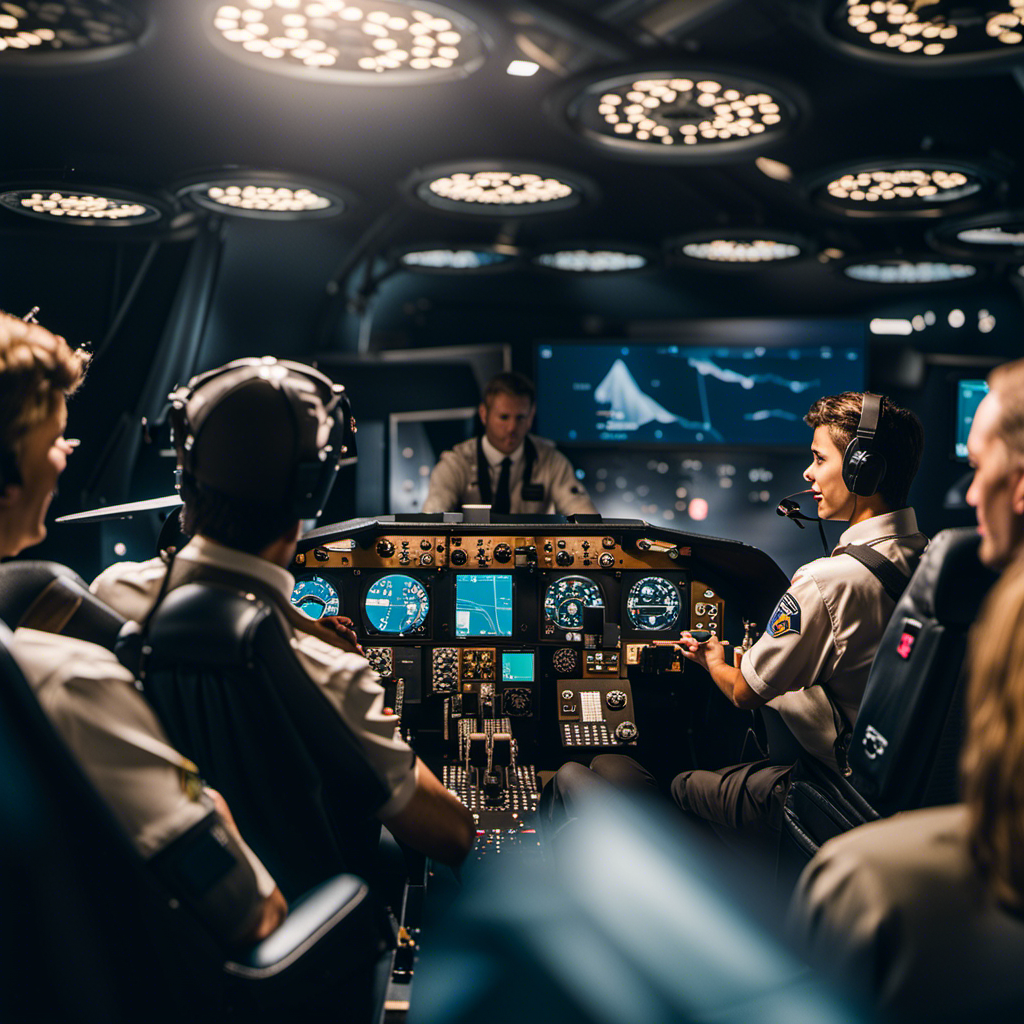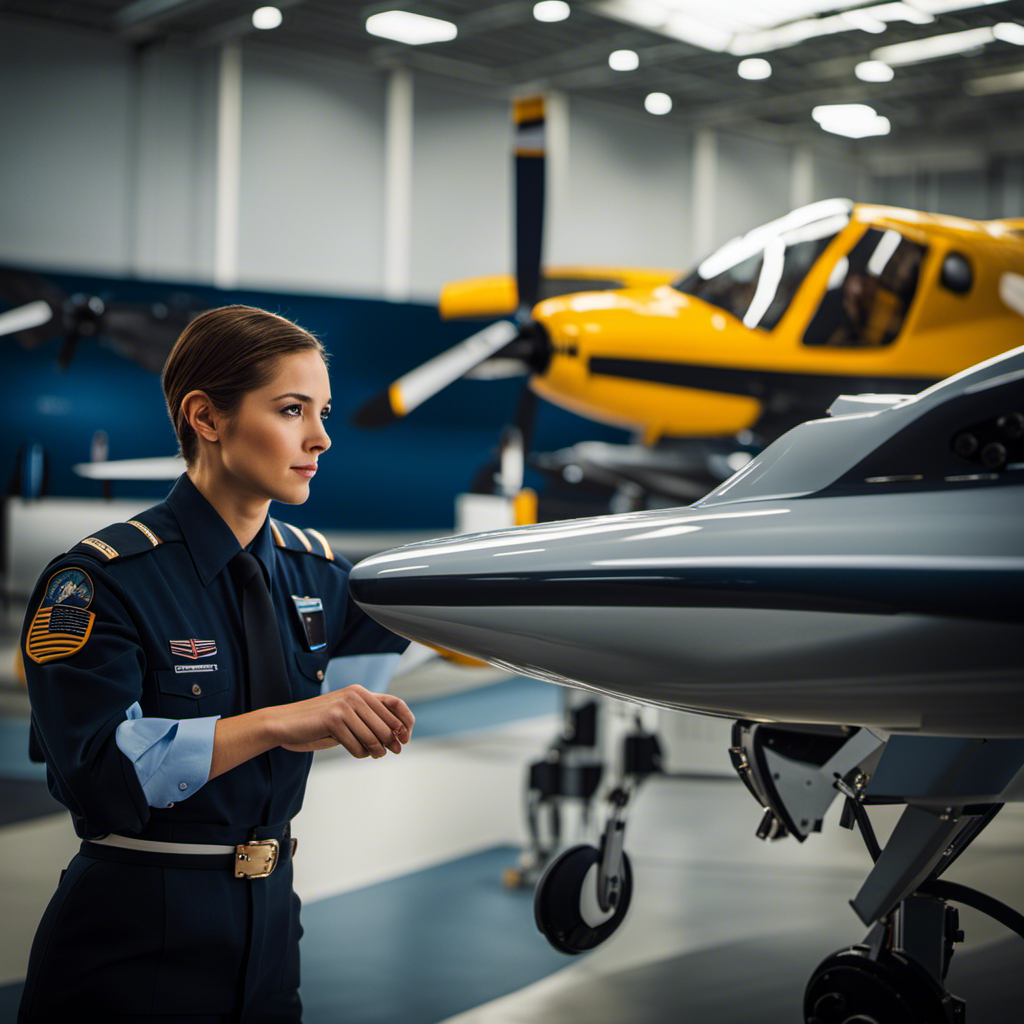I’ve always had a deep interest in the aviation industry, and the idea of becoming a pilot has always been on my mind. The path to becoming a pilot may seem overwhelming and unknown, but don’t worry! In this article, I will clarify the pilot training process and give you all the essential information you need to be aware of.
From the requirements to choosing the right flight school, to the different types of pilot licenses and the training process, I’ll cover it all.
So, let’s dive in and explore the exciting world of aviation together.
Key Takeaways
- Financing pilot training can be done through scholarships, aviation loans, or personal savings.
- Safety and security are of utmost importance in the aviation industry, and pilots undergo rigorous training to handle emergencies.
- Pilot training requires qualifications and experience, covering theoretical and practical aspects of aviation.
- Licensed pilots have job opportunities in commercial airlines and private charter companies, making it a rewarding career choice.
The Requirements to Become a Pilot
To become a pilot, you’ll need to meet certain requirements. Firstly, there are pilot medical requirements that must be fulfilled. These ensure that you are physically fit to handle the demands of flying an aircraft. Depending on the type of pilot license you aim to obtain, the medical requirements may vary. For example, a commercial pilot will need to meet higher medical standards compared to a private pilot.
Additionally, age requirements play a vital role in becoming a pilot. In most countries, the minimum age to obtain a private pilot license is 17, while the minimum age for a commercial pilot license is 18. Meeting these requirements is a crucial first step towards realizing your dream of becoming a pilot.
Now, let’s move on to the next section about choosing the right flight school.
Choosing the Right Flight School
When selecting a flight school, it’s crucial to consider factors such as reputation and accreditation. Here are some key points to keep in mind when exploring flight school options and flight training programs:
- Reputation: Research the school’s track record and success rate of training pilots.
- Accreditation: Ensure that the school is accredited by the appropriate aviation authorities.
- Curriculum: Evaluate the flight training programs offered by the school and determine if they align with your goals.
- Facilities and Equipment: Check if the school has well-maintained aircraft and up-to-date training equipment.
- Instructors: Find out about the qualifications and experience of the flight instructors.
Choosing the right flight school is a critical step towards becoming a pilot. Once you have made an informed decision, you can then move on to understanding the different types of pilot licenses.
The Different Types of Pilot Licenses
There are various types of pilot licenses, each with its own specific requirements and privileges.
One of the most common types is the private pilot license (PPL), which allows individuals to fly for personal reasons. To obtain a PPL, aspiring pilots must complete a minimum of 40 hours of flight time, including at least 20 hours of flight instruction and 10 hours of solo flight. Additionally, they must pass a written exam and a practical flight test.
On the other hand, the commercial pilot license (CPL) is required for individuals who wish to fly for compensation or hire. To obtain a CPL, pilots must have a minimum of 250 hours of flight time, including specific experience in cross-country flights and instrument flying.
Transitioning from a private pilot to a commercial pilot involves additional training and requirements, which we will discuss in the following section.
The Training Process
Get ready to embark on a challenging and rewarding journey as you learn the ins and outs of pilot training. The training process encompasses various stages that are essential in building your skills and knowledge as a pilot. Here are the key components of the training process:
-
Theoretical Knowledge: You will dive deep into subjects like aviation regulations, aerodynamics, meteorology, and navigation. This theoretical foundation is crucial for understanding the principles behind flying.
-
Flight Simulator Training: A flight simulator replicates the cockpit environment and allows you to practice flying without leaving the ground. Through simulated scenarios, you’ll learn how to handle different situations, improve your decision-making skills, and build muscle memory for various maneuvers.
-
Practical Flight Training: This is where you take to the skies and apply what you’ve learned in the classroom and simulator. Under the guidance of experienced flight instructors, you’ll gain hands-on experience, refine your flying techniques, and learn to navigate real-world challenges.
As you progress through the training process and gain proficiency, you’ll eventually reach the stage of accumulating flight hours and meeting experience requirements, which will be discussed in the next section.
Flight Hours and Experience Requirements
Reaching the stage of accumulating flight hours and meeting experience requirements is a significant milestone in the pilot training process. As aspiring pilots, we spend countless hours at flight schools, immersing ourselves in the intricacies of flight training. These institutions provide us with the knowledge and skills necessary to navigate the skies safely and confidently.
However, it is only through the accumulation of flight hours that we truly gain the experience needed to become proficient pilots. Flight hours allow us to practice and refine our skills, honing our abilities to handle various situations that may arise during a flight. It is during this phase that we gain valuable hands-on experience and develop the muscle memory required to become competent pilots.
With an adequate amount of flight hours under our belt, we can move on to the next phase of our training – the written exams and practical tests.
Written Exams and Practical Tests
As I prepare for the written exams and practical tests, it’s important to review and study the material thoroughly. These exams and tests are crucial steps in becoming a pilot, as they assess both theoretical knowledge and practical skills.
The written exams cover a wide range of topics, including aviation regulations, meteorology, navigation, and aircraft systems. It’s essential to study each subject in detail and understand the underlying principles.
On the other hand, practical tests evaluate your ability to apply that knowledge in real-world scenarios. These tests typically involve flying in different conditions, performing maneuvers, and demonstrating emergency procedures.
Building a Career as a Pilot
After successfully completing your written exams and practical tests, you are now ready to embark on your journey towards building a career as a pilot.
The aviation industry offers a wide range of career opportunities, from commercial airlines to private charter companies, and even military aviation. As a pilot, you can choose to fly commercial airliners, cargo planes, helicopters, or even become a flight instructor.
The demand for qualified pilots continues to grow, presenting a multitude of career options and advancement opportunities. Additionally, pilot salaries can be quite lucrative, especially for those who work for major airlines or in specialized fields such as corporate aviation. With the right qualifications and experience, you can expect to earn a competitive salary that reflects the responsibility and skills required for the job.
Now that we’ve explored the exciting career opportunities and potential pilot salaries, let’s delve into the next section, where we will discuss the costs and financing options for your pilot training.
Costs and Financing Options
Now that we’ve covered the career opportunities and potential salaries, let’s take a closer look at the costs and financing options for pilot training.
When considering the financial aspect of becoming a pilot, it’s important to be aware of the following:
-
Scholarships: Many organizations and institutions offer scholarships specifically for aspiring pilots. These scholarships can help offset the cost of training and provide an excellent opportunity for financial assistance.
-
Aviation Loans: If scholarships are not available or do not cover the entire cost of training, aviation loans can be an option. These loans are specifically tailored for pilot training and often offer favorable terms and interest rates.
-
Personal savings: Some individuals choose to save up money to finance their pilot training. It may take longer to accumulate the necessary funds, but it can be a viable option for those who prefer not to rely on scholarships or loans.
Understanding the costs and financing options is crucial in planning your journey towards becoming a pilot.
Now, let’s explore the next important aspect of aviation: safety and security.
Safety and Security in Aviation
Understanding the importance of safety and security is crucial for aspiring pilots, as it is a fundamental aspect of the aviation industry. As pilots, we are responsible for the lives of our passengers and must adhere to strict aviation regulations and emergency procedures to ensure their well-being.
Safety is at the forefront of our minds from the moment we step into the cockpit. We undergo rigorous training to handle various emergency situations, such as engine failures, fires, or loss of cabin pressure. We are trained to react quickly and efficiently to ensure the safety of all onboard.
In the aviation industry, safety is paramount, and it is our duty as pilots to prioritize it above all else. As we delve into frequently asked questions (FAQs), we will explore further aspects of our training and responsibilities.
Frequently Asked Questions (FAQs)
As an aspiring pilot, you may wonder about the qualifications and experience required to become a licensed pilot. The pilot course curriculum is designed to provide you with the necessary knowledge and skills to safely operate an aircraft. It includes theoretical and practical training in areas such as aviation regulations, meteorology, navigation, and flight operations.
Additionally, you will gain hands-on experience through flight simulations and actual flying hours. This comprehensive training ensures that you are well-prepared for the challenges of the aviation industry.
Once you have completed the pilot course, a world of job opportunities awaits you. From commercial airlines to private charter companies, there is a demand for skilled pilots. So, if you have a passion for flying and are willing to put in the hard work, a rewarding career as a licensed pilot awaits you.
Frequently Asked Questions
What is the average salary of a pilot?
The average salary of a pilot depends on various factors such as experience, airline, and location. However, after completing the pilot training duration and acquiring necessary certifications, pilots can expect a competitive salary in the aviation industry.
How long does it take to become a pilot?
It takes several years to become a pilot. The pilot training duration varies, but it typically involves obtaining a pilot certification, which can take anywhere from 6 months to 2 years.
Are there any age restrictions to become a pilot?
Age restrictions for becoming a pilot vary by country, but in the United States, you must be at least 16 years old to fly alone and 17 to obtain a private pilot’s license. Extensive training requirements are also necessary.
What is the retirement age for pilots?
The retirement age for pilots is determined by mandatory retirement regulations. These regulations specify the age at which pilots must stop flying commercially. The retirement age ensures safety and allows for the introduction of younger pilots into the industry.
How often do pilots need to renew their licenses?
Pilots are required to renew their licenses periodically to maintain their qualifications. The frequency of license renewal depends on the type of license and the aviation authority’s regulations. Failure to renew can result in pilot license expiration.
Conclusion
In conclusion, becoming a pilot is a fascinating journey filled with challenges and rewards.
The pilot course is a gateway to soaring through the skies, embracing the freedom and exhilaration that only flying can offer.
It is a meticulous process that requires dedication, skill, and a thirst for knowledge.
However, the hard work and investment are worth it, as the career opportunities in aviation are vast and fulfilling.
So, if you’re ready to spread your wings and embark on a remarkable adventure, the pilot course awaits you.
Bon voyage!
Orion, better known as “Jetstream,” is the voice that brings the stories of the skies to life. His fascination with aviation began at a young age, sparked by his father’s tales of flying and adventure. Orion’s journey into the world of gliding was serendipitous, and from the moment he took his first glider flight, he knew he had found his calling.










